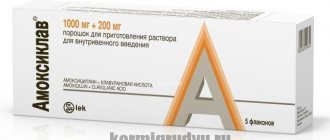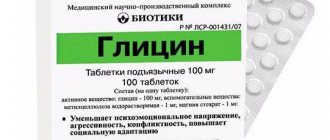Main components and effect of the drug
“Lugol” is a solution for topical use with antiseptic and anti-inflammatory properties.
The main active component of the drug is molecular iodine in dissolved form . Additional components of the composition are glycerol, water and potassium iodide. They provide a milder therapeutic effect of iodine and contribute to longer storage of Lugol.
The therapeutic effect of the drug is due to the chemical properties of elemental iodine. It has an irritating effect on mucous membranes and skin and helps fight infections. “Lugol” has a detrimental effect on a wide range of pathogenic bacteria and stops the further progression of the infectious-inflammatory process.
Important! “Lugol” is not addictive, which distinguishes it favorably from antibiotics and allows for frequent and long-term therapeutic courses.
The drug can irritate the mucous membranes of the upper respiratory tract, causing coughing and sneezing . These physiological processes help to quickly clear microbes and start recovery processes.
Is it possible to treat a nursing mother's throat with Lugol's? Will this harm the baby?
Breastfeeding women are more susceptible to infectious diseases due to weakened immunity. To avoid taking strong medications, it is often recommended to use Lugol. But is it possible to use such a drug during this period without harm to the baby?
Characteristics of the medicine
Lugol is a medicine that actively fights bacteria. The active substance is iodine. The composition also contains glycerin (mitigates the aggressive effects of iodine), hydrogen iodine salts, purified water, and potassium salt. In addition to those indicated, the spray also contains algae extract and sea salt.
The local irritating effect of the drug causes increased mucus secretion and provokes coughing and sneezing. At the same time, pathogenic microflora is removed and washed away from the nasopharynx. With regular use of Lugol, staphylococci are destroyed. There is no habituation to the medication.
Areas of application of Lugol:
- runny nose;
- purulent inflammation of the ear;
- infectious and inflammatory diseases of the mouth and throat, for example, laryngitis, tonsillitis;
- thermal burns with infection;
- infected wounds;
- muscle pain due to hypertension.
Danger for babies
If a mother has a sore throat during breastfeeding, then she would like to find a medicine that is harmless to the baby. Sometimes you can hear reasoning and classifying Lugol as a “folk”, safe remedy. Any medicine has side effects, you need to follow the correct dosage and have a doctor's prescription.
It is necessary to understand that the main active substance of the medicine, iodine, penetrates into mother's milk and accumulates in it. The threat to the newborn is that he may have an excess of this substance. In the future, this may result in problems with the thyroid gland.
Compliance with the permissible dosage is considered harmless to the baby. For example, using Lugol for four days will not cause an overdose in breast milk and will not cause harm to the baby. The use of Lugol will be safer than the use of antibiotics in treatment.
Smoking mothers have a lack of iodine during lactation, so the use of Lugol will supply them with a useful microelement. But self-medication is unacceptable; the treating doctor must prescribe the drug. Only a specialist can evaluate the specific effects of medications on infants.
The instructions for the drug also note that Lugol is used during breastfeeding in case of emergency. There are other ways to treat a sore throat.
A solution of soda and salt helps a lot. A nursing mother needs to rinse 5-6 times every 10 minutes, because the medicine is washed off with saliva.
Such approaches must be done at least six times a day to obtain a positive effect.
If the doctor prescribed Lugol
In some cases, Lugol is prescribed during breastfeeding, despite the undesirability of use. This can happen with purulent sore throat, when there is a threat of developing serious complications.
Following the rules for using Lugol during lactation will reduce the danger to the child:
- Lugol should only be prescribed by the attending physician;
- Treatment with the drug should not last longer than 4 days. This way the baby will not receive an overdose of iodine;
- It is better to use a solution rather than a spray. This reduces the likelihood of aggressive substances entering the respiratory tract, absorption into the blood and penetration into milk;
- Use the drug 4 times a day;
- The medicine should be used after feeding, which will reduce its content in breast milk;
- It is good to express milk for feeding your baby a day before the start of treatment. During therapy there is no need to express milk; you should try to reduce the iodine content in it.
We must not forget that when lubricating damaged skin with iodine, the same rules apply. Especially if a large area is damaged. Iodine is also quickly absorbed through the skin and penetrates into the blood. Nursing mothers should remember this.
Side effects
A nursing woman should closely monitor her health while using Lugol. The occurrence of side effects may be a reason to discontinue the drug. The same manifestations can appear in infants.
Possible side effects:
- copious amounts of saliva;
- increased lacrimation;
- inability to digest food, often in the form of diarrhea;
- superficial sleep;
- disturbing dreams;
- poor sleep;
- allergy-type skin rashes;
- increased activity of children;
- irritability and high excitability.
If such symptoms appear, use of the drug should be stopped immediately and consult your doctor. If the dosage is exceeded, irritation of the respiratory tract begins. There is a possibility of getting burned by iodine. Exceeding the permissible dosage up to 300 ml can be fatal.
Conclusion
According to medical statistics, the majority of the population of our country suffers from iodine deficiency, so doctors can prescribe medications containing this microelement to women during pregnancy and breastfeeding. When treating with Lugol, such medications are no longer used. That is why all medications must be prescribed by a doctor; he has knowledge of previously prescribed medications.
Modern doctors use Lugol's solution for treatment of hepatitis B less and less often. Other less aggressive antiseptic drugs are appearing. But replacing one drug with another on your own is not recommended. Only a doctor can do this competently. He will take into account all contraindications and side effects. You can’t risk your health, especially for nursing mothers.
Source: https://ogrudnichke.ru/grudnoe-vskarmlivanie/mozhno-li-lechitsya-lyugolem-kormyashhej-mame.html
Can it be used for breastfeeding?
There is evidence that “Lugol”, when applied to the skin and mucous membranes, is able to be absorbed into the bloodstream and is subsequently found in breast milk.
Only a doctor can accurately answer the question of whether the drug can be used during lactation. “Lugol” is prescribed only if the benefit to the mother’s health significantly outweighs the potential risk to the baby. Iodine molecules can accumulate in the thyroid gland, causing hormonal imbalances. Therefore, any iodine-based medications must be used with extreme caution. Self-medication with Lugol for nursing mothers is prohibited.
Lugol when breastfeeding a mother
In this article we will figure out whether it is possible to smear the throat with Lugol during breastfeeding, and what precautions must be taken. This remedy is very popular and is therefore included in many home first aid kits.
Just remember that with breastfeeding, not all drugs can be beneficial for the baby, and some can be harmful.
It is important to know that the main active ingredient in this medication is iodine, which tends to penetrate and accumulate in breast milk. As a result of using Lugol during breastfeeding, the baby may experience an excess of this microelement, which can lead to problems with the thyroid gland.
Lugol's during pregnancy is completely contraindicated in all trimesters, and treatment of children with this remedy can be carried out only after reaching the age of 5 years.
If mom has a sore throat and there are no serious complications, it is better to use safer remedies. Regular rinsing with baking soda and salt helps (up to 12 times a day).
If a serious illness occurs, such as purulent tonsillitis, the attending physician may prescribe Lugol and antibiotics. If you have a sore throat, you cannot self-medicate, as this disease has very serious complications in the form of rheumatism and other problems. In this case, the doctor may prescribe antibiotics that are fully compatible with breastfeeding.
It is also worth noting that there are safer antimicrobial agents for treating a sore throat during lactation, which a doctor can select.
But if, for some reason, you decide to use Lugol, then it is important to remember that the course of its use should not exceed 4 days. With prolonged combination of lactation and the use of this medication, we can talk about the appearance of side effects that are unsafe for the baby.
There are 2 options: Lugol spray and Lugol solution. When breastfeeding, it is recommended to use the solution, as there is less chance of it getting into the respiratory tract. This drug is sold in bottles made of dark glass.
In Lugol's solution, the main active ingredients are iodine and potassium iodide. Glycerol, sea salt, and kelp extract are also added to the spray to enhance the effect.
Iodine has good antiseptic properties. Its activity against yeast and pathogenic fungi has been established. If the solution is used to treat a large area of skin, you can notice the beginning of the synthesis process.
When a mother has a sore throat while breastfeeding, she simply needs to take care of the correct use of Lugol. If the solution comes into contact with the mucous membrane, it partially turns into iodide. In case of accidental ingestion, complete absorption of iodine is observed, which accumulates in the thyroid gland and passes into breast milk.
When it gets on the mucous membrane of the throat, Lugol creates a protective film and acts as an antiseptic. The product can be used up to 4 times a day.
A nursing mother should carefully choose the time to use the medicine. This is necessary so that during breastfeeding the concentration of the drug in the milk decreases. It is better to use Lugol immediately after feeding and take as long a break as possible before the next feeding. In this case, there is no need to pump. When the amount of iodine in the blood decreases, its content will automatically decrease in breast milk due to diffusion and the blood-milk barrier.
The solution can be used only after a doctor's prescription. If a woman has individual hypersensitivity, then she is not recommended to use the drug.
Lugol can cause:
profuse lacrimation; a large amount of saliva; Quincke's edema; diarrhea; sleep disorder; allergic skin rashes; increased excitability.
If other reactions occur, you should immediately stop using the solution.
If the permissible dose is significantly exceeded, irritation of the respiratory tract occurs and a burn may occur. If a large amount of the drug gets inside, hemolysis may occur. Doctors call taking 300 ml fatal, after which sodium thiosulfate is injected intravenously and the stomach is washed out with sodium bicarbonate.
Lugol's is a popular antiseptic that is used to treat inflammatory diseases of the throat, nose and skin infections. The medicine is used locally and externally.
During lactation, women's immunity is weakened, and therefore they are more susceptible to infections than others. To avoid taking medications that are dangerous for the child, the disease is treated at an early stage. Often young mothers use Lugol's solution or spray for this. How safe is it? More on this later.
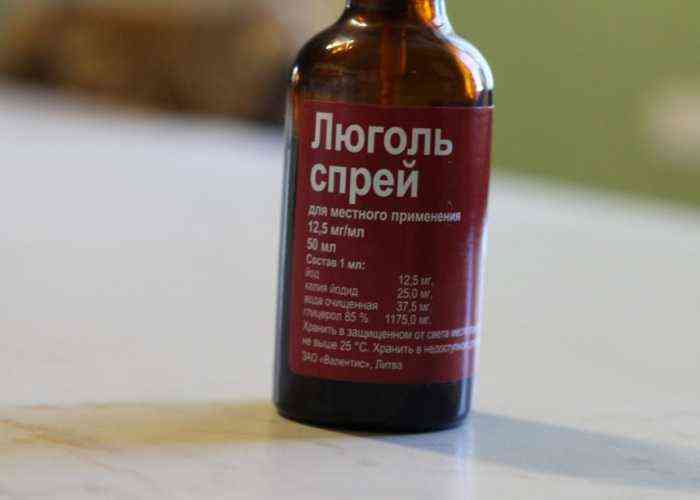
Lugol is a drug with a pronounced antiseptic effect.
The main active ingredient is iodine. Additional components:
glycerin, which softens the effect of iodine; potassium salt of hydroiodic acid; purified water.
The spray additionally contains sea salt and algae extract. The concentration of the active substance is 1% and 1.25%. The drug is available in the form of a solution, which is placed in a dark glass bottle or bottle with a spray device (spray). Volume – 20, 25, 30, 40, 50 and 60 ml. Thanks to iodine, the liquid has an orange color and a characteristic odor of iodine, and the consistency is thick.
Lugol has an antiseptic, local irritant effect on the oral, nasal cavity or skin. The active component is effective against opportunistic and pathogenic microorganisms (bacteria, fungi). The drug stops the reproduction of viruses and the progression of the disease.
With long-term systematic use, the medication destroys staphylococci. Pseudomonas aeruginosa is resistant to Lugol. The drug is not addictive.

Iodine accelerates the production of mucus and provokes coughing and sneezing. Thanks to the locally irritating effect of iodine, bacteria are washed away with mucus. In addition, the internal membranes are disinfected using biologically active substances.
The drug penetrates the blood from the inner membranes and skin. When treating small areas of skin or mucous membranes with Lugol, a little of the active substance penetrates inside and is quickly excreted through the kidneys. If you treat a large area with the drug, iodine accumulates in the thyroid gland and participates in the metabolism of thyroid hormones.
Lugol is used to treat the following ailments:
infectious, inflammatory diseases of the oral cavity and pharynx (tonsillitis, laryngitis, pharyngitis, etc.); atrophic runny nose; acute purulent inflammation of the ear; infectious and inflammatory skin diseases (boils, erysipelas, purulent wounds, etc.); trophic ulcer; varicose nodes in ulcers; thermal burns (1st–2nd degree); burns accompanied by infection; muscle pain due to hypertonicity of muscle cells.

Lugol is strictly contraindicated in the presence of hypersensitivity to the components of the drug. This is an absolute contraindication; the following diseases can be classified as temporary:
thyrotoxicosis; tuberculosis; diathesis; dysfunction of the liver, kidneys; Dühring's dermatitis; chronic pyogenic ulcer; children under 6 years old; pregnant women.
The drug sometimes irritates the internal membranes and skin.

Due to prolonged use or when applied to large areas, iodism may occur, which has the following symptoms:
rhinitis; angioedema; myasthenia gravis; slow progression of mental processes; increased salivation; tearfulness; blackheads
If accidentally swallowed, there is a risk of allergic reactions such as skin rash, itching. It is also possible to increase the frequency of myocardial contractions (from 90 beats/min), irritability, sleep disorders, increased sweating, diarrhea.
In case of overdose, you can burn your respiratory tract. When a large amount of Lugol is ingested, hemolysis occurs (the destruction of red blood cells and the release of hemoglobin into their environment). If 300 ml of solution gets inside, the person may die. To help, doctors administer hyposulfite intravenously and rinse the stomach with sodium bicarbonate.
Lugol can be taken during lactation only if the expected benefit to the mother is higher than the potential risk to the newborn.
Upon contact with the inner shell, the drug turns into iodide. If a lactating woman accidentally swallows the solution, the iodine will penetrate into the bloodstream and mother's milk and accumulate in the thyroid gland.

When the drug enters the oral or nasal cavity, it destroys bacteria and stops their reproduction. It acts as a protective shell. You can treat the mucous membrane or skin three times a day.
A woman who is breastfeeding should calculate the time to take the drug. This is necessary so that during feeding the concentration of the active substance in the milk decreases. You need to use the solution immediately after feeding, then you need to take a long break before the next feeding. There is no need to express milk. As the concentration of iodine in the bloodstream decreases, the amount in milk will also decrease.
Only the attending physician can prescribe the drug!
If dangerous diseases such as acute tonsillitis occur, the doctor may prescribe Lugol with antibacterial drugs. Self-medication is strictly prohibited, as this can lead to serious complications, such as rheumatism.
When using Lugol, adhere to the following rules:
The maximum course of treatment for breastfeeding is 4 days, otherwise an overdose and side effects are possible. It is safer for a lactating woman to take a solution rather than a spray, this reduces the risk of the drug entering the respiratory tract. As a result, the components do not penetrate into the bloodstream and mother's milk. On the mucous membrane, the medication forms a protective film that protects against harmful microorganisms. When the solution is swallowed, iodine penetrates into the blood, and when the active substance penetrates the stomach, it is completely absorbed. The solution should be applied after feeding so that the iodine concentration decreases.

24 hours before using the drug, it is better to express milk and feed it to the newborn. There is no need to pump during treatment. The drug should not be used if a nursing mother has an individual intolerance to its components. This is dangerous not only for the patient, but also for her child. The choice of the appropriate composition is solely the responsibility of the attending physician! In addition to the traditional solution, there is a spray that, in addition to the main components, contains an extract from algae and sea salt. The spray often provokes an allergic reaction, so it is better to give preference to the standard solution.
Lugol's is dangerous for children, and therefore lactating women should refrain from using the drug. Modern pharmacology has drugs that are effective and safe for newborns. But if this drug cannot be replaced by another, follow simple rules, and then your child will be safe.
Young mothers are significantly susceptible to the development of infectious processes, which must be treated in the early stages in order to prevent complications that require serious medical intervention. A few years ago, for inflammatory processes in the throat, people used Lugol to treat the mucous membrane.

Modern experts classify this solution as a high-risk solution for the child and do not recommend using it during breastfeeding. In modern pharmacology you can find no less effective, but absolutely safe for infants. If the situation is such that the use of a particular product is necessary for medical reasons, simple precautions must be observed.
The main active ingredient, thanks to which Lugol gives such a pronounced antiseptic effect, is iodine. If its use in normal times is quite justified, provided that dosages and timing are observed, then with hepatitis B the risk is too high.
The active microelement enters the mother's milk, passes into the child's body and accumulates in it, causing an excess of iodine in the tissues. This negatively affects the thyroid gland and can lead to serious systemic disorders.
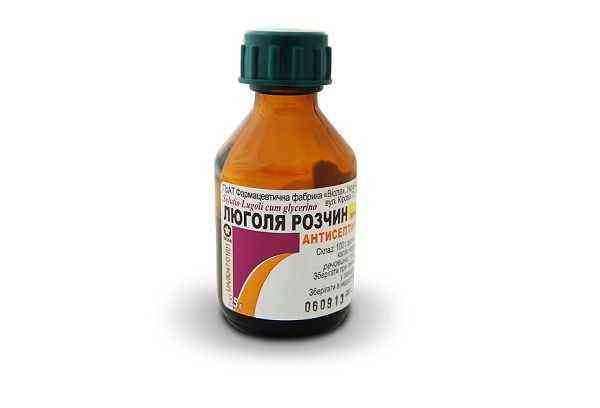
Tip: The optimal composition for gargling a nursing mother is a mixture of soda and salt, diluted in boiled water. It can be used up to 12 times a day until the desired effect is obtained, but the approach only works in the absence of complications caused by prolonged exposure to bacteria and viruses.
If you carefully read the instructions for the drug, you will see that Lugol is allowed for use during breastfeeding only if this will provide a benefit for the mother that exceeds the potential risk for the baby. Experts recommend refraining from using the drug during pregnancy.
It is indicated for children no earlier than reaching the age of five. We must not forget the numerous side effects that can accompany such treatment. Cases of unintentional overdose of the solution are not so rare.
In some cases, only by using Lugol can you count on obtaining the expected therapeutic result. This can happen with purulent tonsillitis, when self-medication and refusal of proven remedies can lead to the development of rheumatism and other serious problems. In this case, you need to remember the following points:
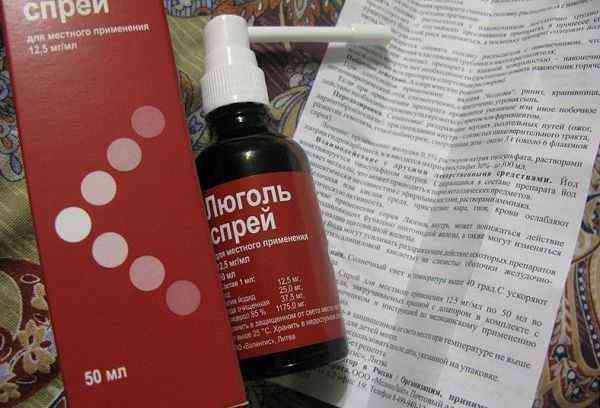
The duration of local therapy should not exceed 4 days. Exceeding this indicator very often leads to complications in the form of side effects. For breastfeeding, it is better to use a traditional solution rather than a convenient spray. The lower likelihood of the composition entering the respiratory tract reduces the degree of its absorption into the blood and passage into breast milk. Once on the mucous membrane, Lugol turns into a thin film that acts as an antiseptic. The less mother swallows it, the less product will enter the bloodstream. It is necessary to take into account that when the composition enters the stomach, iodine is absorbed into the blood in full. It is necessary to use the composition immediately after feeding, this will reduce the concentration of the drug as much as possible. If possible, at least a day before using the solution, it is recommended to express milk as much as possible and give it to the child. Already during the therapy period there is no need to express additionally. It is strictly forbidden to use Lugol if the mother has hypersensitivity to the product or its components. This will not only cause the woman many uncomfortable moments, but will also negatively affect the condition of the baby. Particular attention should be paid to the process of selecting a suitable composition. Today, in addition to the traditional drug, you can find a product with the addition of kelp extract, sea salt, and glycerol. Often they provoke a violent allergic response.

The listed measures must also be observed when treating the skin, especially if a large area is affected.
Indications
The drug has found widespread use in the treatment of such diseases.:
- angina;
- chronic tonsillitis;
- laryngitis;
- pharyngitis;
- atrophic runny nose;
- purulent form of otitis;
- infectious skin lesions with scratches, wounds and suppurations;
- varicose veins with ulcerated nodes;
- trophic ulcers;
- thermal burns;
- muscle pain.
Attention! Lugol's solution is intended exclusively for topical use - ingestion of the mixture can cause burns to the esophagus and stomach.
Indications for use
Lugol is used in the treatment of various types of viral respiratory infections (angina, pharyngitis, tonsillopharyngitis)
Side effects of Lugol
- allergic reactions;
- rhinitis;
- angioedema;
- hives;
- lacrimation,
- salivation,
- acne.
There are very few contraindications for prescribing Lugol: hypersensitivity to the drug or its components.
Use of Lugol during pregnancy
The use of Lugol during pregnancy and lactation is contraindicated according to the instructions. But the opinions of doctors on this matter are very different. Some are categorically against prescribing Lugol during pregnancy, since there are no reliable studies on its safe use during such a period. Others (the majority) consider the drug absolutely safe.
The use of Lugol during breastfeeding is possible only locally and in short courses. Iodine can pass into breast milk and can potentially affect the baby's thyroid function.
Methods of using Lugol's dosage forms
Lugol's solution - a cotton swab is moistened in the prepared solution, and the tonsils, pharynx and larynx are treated by lightly wiping. The duration of the course is no more than 10 days. Please note that the drug slightly dries out the mucous membranes. Therefore, for severe pain in the throat and constant sore throat, it is better to use Lugol with glycerin.
Lugol spray is used for local irrigation of the mucous membrane of the pharynx, pharynx, mouth, from 2 to 6 rubles/day. depending on the course of the disease.
Interaction
Iodine, which is part of the drug, promotes the oxidation of metals, which can damage metal surfaces and tools. Incompatible with ammonia solutions and essential oils. Its antiseptic activity is weakened by an alkaline or acidic environment, the presence of blood, pus, and fat. If the drug is taken orally, it can reduce the effects of drugs that suppress thyroid function. Iodine-based drugs may increase the likelihood of some drugs irritating the gastrointestinal mucosa.
Lugol spray for children
Relatively recently, Lugol spray for children appeared in pharmacies. The medicine is used topically 4-6 times a day. for the purpose of irrigating the oral cavity, pharynx, pharynx, spraying the spray with 1 press of the spray head. You need to hold your breath while injecting.
The use of Lugol spray for children with infectious diseases of the upper respiratory tract is more than justified. In addition to the fact that its composition is quite simple, the drug has a powerful disinfectant effect. Lugol's components attack pathogenic bacteria and have a soothing and anti-inflammatory effect on the throat. At the same time, the swelling of the larynx quickly subsides, the pain disappears. Not to mention easy to use.
Use of drugs Lugol for sore throat
The use of Lugol is effective in the combinatorial treatment of angina. But it is advisable to use it in mild cases. In case of severe inflammation, antibiotics are used. Until our time, Lugol was produced exclusively in the form of a solution. The appearance of the spray greatly simplified the treatment of sore throat with this drug.
For angina, the drug is used to irrigate the mucous membrane of the pharynx, pharynx, and mouth from 2 to 6 times a day. taking into account the severity of the disease. Spraying is carried out with one click on the spray head. Before irrigation, you need to take a deep breath and hold the exhale. Do not drink or eat for about 30 minutes after injection. Lugol's solution for sore throat is most conveniently used using tweezers with a cotton swab to lubricate the tonsils and oral cavity.
Analogs
Nowadays there are many drugs that are similar in their effects to Lugol. But they contain completely different substances. The most common of them are Anginal Hexoral, Anzibel. Analogs for the active ingredients are: Yox, Polividone, etc.
Prices for Lugol's drugs
The cost of Lugol in pharmacies is on average affordable: solution - from 10 rubles, spray - from 100 rubles.
Contraindications and side effects
The main contraindication to treatment with Lugol is individual sensitivity reactions to iodine and other substances included in the solution.
There is a list of diseases for which the medication must be used with caution and under medical supervision. The list includes:
- hyperthyroidism – excess thyroid hormones;
- tuberculosis of the lungs;
- hemorrhagic diathesis;
- dysfunction of the liver and kidneys;
- Dühring's disease is a disease accompanied by an itchy rash;
- purulent pyoderma in chronic form.
If there are one or more contraindications, it is necessary to refuse treatment with Lugol and select an alternative remedy.
The drug has a pronounced irritant effect, so it can cause signs of allergic reactions when applied to the skin and mucous membranes.
Long-term use of Lugol's solution can provoke the appearance of iodism with such symptoms:
- runny nose;
- muscle weakness;
- lethargy;
- increased salivation;
- lacrimation;
- acne.
Severe side effects when swallowing the medicine:
- skin allergies;
- cardiopalmus;
- nervousness;
- excessive sweating;
- diarrhea;
- sleep disorders.
Lugol spray during lactation: is it possible or not, the effect on the body
14.04.2020 | 294
The liquid discovered almost 200 years ago by the scientist Lugol is still used today.
Initially, it was used to treat the thyroid gland, then it began to be used in the treatment of wounds; currently Lugol is widely used to treat inflammation of the throat [1].
The drug is quite simple in its structure, but this makes it no less effective and in demand, since it copes excellently with disinfection at the site of its use.
Is it that simple? Is the use of Lugol justified during breastfeeding or should treatment with it be abandoned? What effect does the drug have on breast milk and the baby?
Composition and release form
A viscous liquid with a color ranging from red to brown, with a specific odor of iodine. The composition includes iodine, purified water, glycerin. Iodine is responsible for the bactericidal effect, its concentration is usually 1-1.25%, glycerin softens.
The drug is packaged in cardboard boxes. The solution is contained in a dark glass vessel, which may include a dispenser or an aluminum bottle with a spray nozzle. Packaging volume from 25 to 60 g. Production is carried out both in Russia and abroad. [2]
Spraying in the oral cavity has the effect of irritating the mucous layers and provokes secretion - the outflow of mucus, removing foreign microflora. The main active ingredient specifically fights all types of microbes, fungi (yeast), and with long-term use, staphylococcus.
Products are eliminated mainly through the urinary system, namely through filtration by the kidneys. Traces of excretion are also present in sweat and feces.
It is also noted that a dose of 3 g. (about 300 ml) is considered fatal, so the medicine must be stored out of the reach of small children. Neutralization is carried out using sodium thiosulfate (antidote).
Is it possible to take Lugol during lactation?
The first thing you should pay attention to is that taking the drug is prohibited during pregnancy, since the iodine included in the composition can affect the intrauterine development of the child.
The use of the spray during breastfeeding is possible, but the drug is prescribed only by the attending physician. It should be used with extreme caution if you have thyroid disease, tuberculosis, or sensitivity to iodine.
Effect on breast milk
Ingestion of the drug is unacceptable, since iodine enters the body and accumulates in the thyroid gland, quickly penetrates the circulatory system and passes into mother's milk.
For treatment, you should choose the form of rinse solution - this will help prevent penetration into the blood and breast milk. To prepare it, you need a glass of warm water 200 ml and 15 ml (tablespoon) of the medicine itself.
It is recommended to apply the spray after feeding the baby - this will minimize the presence of the active substance in the blood and milk before the next feeding of the baby. In this case, pumping is not carried out.
You can provide a supply of expressed milk. The first pumping is carried out 24 hours (or earlier) before the start of treatment, in which case the drug is taken as necessary, but not more than the period determined by the doctor.
Effect on the newborn baby
In case of infection of the throat and mouth, the drug is sprayed directly onto the mucous layer of the pharynx; during irrigation, do not inhale. Treatment of infected areas is carried out up to 4 times a day for no more than four days - this is the maximum period of treatment with the drug and they are usually prescribed only in extremely difficult situations, since there is a potential danger to the child’s health.
Exceeding doses may be accompanied by irritation of the skin, burns, anxiety, diarrhea, and increased excitability. Some side effects may also occur in infants if the concentration of iodine in milk exceeds the permissible limits.
Contraindications
If the sick woman’s history even contains a suspicion of AIT or hyperthyroidism, then treatment with an iodine-containing drug should not be prescribed, as this can provoke inflammation of the thyroid gland. It is important to note that in such cases, iodine is not added to the rinsing solution (only soda and sea salt).
If you feel discomfort while taking the medication, you should stop taking it immediately.
It is strictly forbidden to use the drug together with hydrogen peroxide. Not compatible with essential oils and ammonia solutions. Lugol's performance decreases in acidic and alkaline environments, as well as in the presence of blood, pus and other secretory fluids.
Summarizing
The drug Lugol can be purchased in pharmacies without a doctor’s prescription, but, as can be seen from the article, the drug cannot be considered harmless, although it is low-toxic.
In conclusion, it should be noted that the use of Lugol during lactation is not always justified, since the risk is quite high. Every woman, caring for her child, should think about finding out alternative ways before starting treatment with this drug. You can resort to such a seemingly “folk” medicine only in case of a severe form of the disease.
Bibliography:
In 2020 she graduated from the Federal State Budgetary Educational Institution of Higher Education “National Research Mordovian State University named after. N. P. Ogareva”, specialty “Pediatrics”.
Series and registration number of the diploma: 101318 0420079
Source: https://KormiGrudyu.ru/lyugol-pri-laktatsii
How does breastfeeding affect lactation and the baby?
During Lugol therapy, iodine molecules are found in the blood and breast milk . Iodine is absorbed through the skin and mucous membranes, and penetrates especially quickly into biological fluids if accidentally or intentionally ingested.
Iodine cannot affect the lactation process, but getting it into the child’s body is fraught with allergic reactions. A nursing mother should monitor the baby's condition after each feeding. Skin rashes, anxiety, and bowel movements may indicate an allergy to iodine.
In severe cases, long-term use of Lugol can lead to the accumulation of iodine in the thyroid gland and disruption of the endocrine system.
Reference! Iodine loses its beneficial properties when exposed to ultraviolet radiation, so the solution must be stored in a cool, dark place.
Is it possible to use Lugol's solution for a nursing mother?
When treating any disease during lactation, the health of her baby is important to every caring mother. This means that she can only use medications that have been tested and approved for breastfeeding. Their list is not as large as we would like. For example, Lugol for breastfeeding: is the medicine safe and in what form should it be used by a nursing mother?
Lugol's solution or Lugol's spray, if necessary, can be used by a nursing mother in compliance with appropriate safety measures.
Characteristic properties of the drug
Lugol's is an antibacterial agent. The main active ingredient in the drug is iodine. It is supplemented by such auxiliary substances as glycerin, which has a softening effect, hydrogen iodide salts, pure water, and potassium salt. In addition to the indicated ingredients, the spray also includes algae (their extract) and sea salt.
The drug acts at the local level - when the nasopharynx is irritated, mucus is released, sneezing and coughing are activated. This releases bacteria and cleanses the microflora. Frequent use helps fight staph infections. At the same time, the drug does not cause addiction.
Release form and components included
First of all, Lugol is used as an antiseptic.
The drug is available in the form of a spray, which additionally contains only 1% sea salt and approximately 1.3% algae extract, and also in the form of a solution in a glass container.
The volume of the drug can be different - from 20 to 60 ml. The consistency of the medicine is quite thick, has an iodine odor and a pronounced orange color.
Pharmacology of the drug
In addition to the antiseptic effect, Lugol has a local irritating effect in the nose, mouth, and skin. The active particles of the substance act on bacteria and fungi, that is, on pathogenic or opportunistic microorganisms. The product prevents the multiplication of viruses and also prevents the further spread of the disease.
When used topically, mucous membranes are also disinfected. At the same time, the drug enters the bloodstream. When treating the skin (minor lesions), slightly less active substances penetrate inside, which are excreted through the kidneys.
But even when treating a large area of skin, iodine begins to accumulate in the thyroid gland, thereby affecting hormonal metabolism in the thyroid gland.
In what cases can Lugol be used?
Whether Lugol is recommended for breastfeeding or not is difficult to answer unequivocally. Most likely, if there are medical indications, the therapist may prescribe this remedy. In addition, Lugol is used in the treatment of:
- inflammatory process or infectious lesion of the oral area and pharynx - pharyngitis, tonsillitis, laryngitis;
- atrophic runny nose;
- inflammation of the ear in acute or purulent form;
- inflammation of the skin, infectious diseases - boils, wounds with suppuration, erysipelas;
- trophic or peptic ulcers of varicose nodes;
- thermal burns (1st or 2nd degree);
- burns in an advanced stage or with infection;
- muscle pain resulting from hypertonicity.
Dangerous consequences for the child
Some mothers are not afraid to use Lugol during lactation, arguing that it is often classified as a traditional medicine. You just need to follow the exact dosage and there will be no problems.
But we must not forget that iodine penetrates and accumulates in breast milk.
And for a child’s body, this is the biggest danger when the mother takes this substance - it can also accumulate in his body and cause problems with the thyroid gland.
It is better to use Lugol's solution than to treat your throat with antibiotics.
A minimal course of treatment will not lead to particularly dangerous consequences. Sometimes a small dose of iodine can even be beneficial for women, such as those who smoke while breastfeeding. Since when smoking there is almost always a deficiency of it.
Antibiotics during breastfeeding: permitted and prohibited drugs for a nursing mother
Smoking and breastfeeding: what should a nursing mother do?
Using Lugol during breastfeeding
The drug is prescribed for breastfeeding only if the beneficial result for the mother is much greater than the possible risk to the health of the newborn.
Ingestion of the solution is not recommended, since iodine can penetrate into the blood or milk, and it will also accumulate in the thyroid gland. To reduce its concentration in milk, the mother should choose the right period for using the medication.
It should be used after the next feeding, then take a long pause until the next one.
Expressing milk while taking Lugol will not help in any way to reduce the iodine content in milk, so this procedure is not necessary.
As soon as the level of iodine in the blood decreases, its content in breast milk will also decrease. Lugol in the form of a spray is aimed at protecting the mucous membranes or skin, forming a kind of film. In case of damage, it is allowed to treat the surface up to three times per day.
How to use the medicine
To begin with, it is worth saying that only a doctor can prescribe a medicine and only when the following rules are met:
- Treatment when breastfeeding should not exceed four days - this may cause adverse reactions or an overdose.
- Lugol spray is less safe during breastfeeding than the solution.
- Application of the solution is recommended only after feeding.
- If possible, express the milk first and feed it to the baby during treatment. If not, pumping is not necessary.
- In case of individual intolerance, the use of the product is not recommended due to possible complications on the child’s health.
Strict adherence to the rules for using Lugol during breastfeeding will ensure a quick recovery for the nursing mother without any trouble for the baby.
Since Lugol is not indicated for use in children, it is better not to use it for nursing mothers. But if the use of other medications is impossible, and there is a risk to the woman’s health, then the drug can be used in strict accordance with the doctor’s recommendations and the exact dosage.
Source: https://prostoGV.ru/healthandbeauty/medicaments/lyugol-pri-gv








